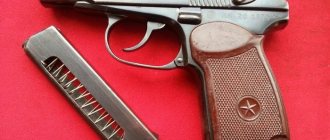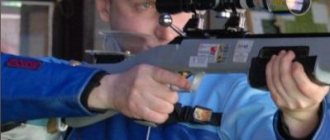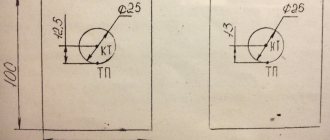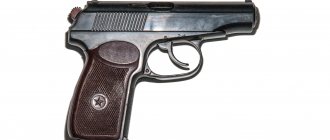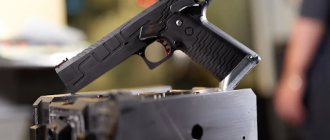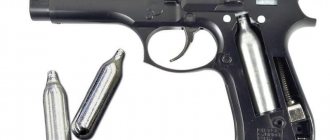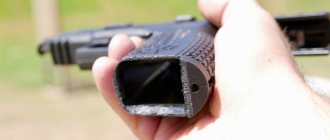Starting position of the Makarov pistol "PM"
The shutter casing is in the extreme forward position, the return spring has the least compression. The trigger is released, under the action of the wide feather of the mainspring, it is pulled back somewhat (“release” the trigger) and put on the safety cock; both mainspring feathers have the least amount of compression. The trigger is in the extreme forward position. The trigger rod with the cocking lever, under the action of the narrow feather of the mainspring, moves to the rearmost position; The self-cocking protrusion of the cocking lever is engaged with the self-cocking tooth of the hammer so that when the trigger is pressed, the hammer is self-cocked. The magazine is inserted into the handle; the feeder is in the upper position, resting against the ridge of the bolt; the feeder hook presses on the slide stop so that when the bolt is pulled back, the front end of the slide stop will be raised up by the feeder.
Position of pistol parts and mechanisms before loading
34. The parts and mechanisms of the pistol are in the following position before loading.
Gate
under the action of the return spring - in the extreme forward position; the bolt cup rests against the breech section of the barrel, as a result of which the barrel is locked with a free bolt. The longitudinal protrusions of the shutter fit into the grooves located in the rear of the frame. The bolt and frame are locked with a safety rib.
The trigger, under the action of the wide feather of the mainspring, is lowered and rests with its front plane against the fuse protrusion so that it cannot move forward.
sear
the shelf of the ledge on the safety axis is raised up and held in such a position so that there is a small gap between the safety cocking of the trigger and the nose of the sear.
Trigger rod with cocking lever
under the action of the narrow feather of the mainspring, it is retracted to the rearmost position; The cocking lever is recessed into the frame and its self-cocking protrusion is engaged with the trigger's self-cocking tooth so that when the tail of the trigger is pressed, the hammer is not cocked, but has some free movement back.
Shop
inserted into the base of the handle. The feeder is at the top and rests against the ridge of the bolt. The feed tooth presses on the bolt stop.
Fuse box
is in the “safety” position. In this case, the fuse protrusion is lowered down and comes into contact with the front plane of the trigger; the ledge shelf on the fuse axis, by acting on the sear tooth, lifts the sear up and holds it in this position; the safety hook enters the trigger recess and, resting against its protrusion, locks the trigger in the “safety” position so that it cannot be cocked; the fuse rib extends beyond the left protrusion of the frame and locks the bolt with the frame.
Loading the Makarov PM pistol
To load the pistol you must: remove the magazine from the pistol handle by moving the magazine latch back; equip the magazine with eight rounds; insert the loaded magazine into the pistol grip; move the shutter to the rearmost position and release it sharply. When inserting a loaded magazine, the magazine latch slides over the protrusion on the wall of the magazine. The upper cartridge rests on the ridge of the bolt and lowers all the cartridges down slightly, additionally compressing the feeder spring. When the bolt casing moves back, it turns the trigger, compresses the return spring and stops when it meets the ridge of the trigger guard. The trigger, turning, with the front part of the annular recess moves the trigger rod with the cocking lever forward upward, bringing it to the protrusion of the sear. The sear, under the action of a spring, jumps its nose behind the cocking cock. After the bolt passes through the magazine, the upper cartridge, under the action of the feeder spring, rises up until it stops at the bends of the magazine walls and becomes in the path of movement of the bolt. When moving forward, the bolt casing, under the action of the return spring, removes the cartridge from the magazine, sends it into the chamber and locks the barrel. The ejector with its hook jumps into the annular groove of the cartridge. The gun is ready to fire.
9-mm Makarov pistol (PM). Manual on shooting (7 pages)
When a loaded magazine is inserted into the base of the handle, the magazine latch slides over the protrusion on the wall of the magazine and holds the magazine in the base of the handle. The upper cartridge rests against the ridge of the bolt. The feeder is located at the bottom; its tooth does not act on the bolt stop.
When the safety is turned off (the flag is turned down), the safety protrusion rises and releases the trigger. When turning the safety, its hook, coming out of the trigger recess, releases the trigger protrusion, which ensures free retraction of the trigger. The shelf of the ledge on the safety axis releases the sear, which falls slightly down under the action of its spring, and the nose of the sear becomes in front of the safety cocking of the trigger (the trigger is on the safety cocking). When you turn the safety, its edge comes out from behind the left protrusion of the frame and separates the bolt from the frame. In this case, the shutter can be pulled back by hand.
When the shutter is pulled back, the following happens.
The shutter, moving along the longitudinal grooves of the frame, turns the trigger. The sear, under the action of a spring, jumps its nose behind the cocking cock. The rearward movement of the shutter is limited by the ridge of the trigger guard. The return spring is under maximum compression.
When the trigger is turned by the front part of the annular recess, it shifts the trigger rod with the cocking lever forward and slightly upward, due to which part of the free play of the trigger is selected. When the cocking lever is lifted up, its cutout approaches the protrusion of the sear.
The magazine feeder, under the action of the feeder spring, lifts the cartridges up so that the upper cartridge becomes in front of the bolt rammer.
When the bolt is released, the return spring sends the bolt forward. Moving along the longitudinal grooves of the frame, the bolt rammer moves the upper cartridge into the chamber. The cartridge, sliding along the curved edges of the side walls of the magazine body and along the bevel on the tide of the barrel and in the lower part of the chamber, enters the chamber and rests with the front cut of the sleeve against the chamber ledge; The barrel bore is locked with a blowback bolt. The second cartridge, under the action of the feeder spring, is lifted up by the feeder until it stops against the bolt ridge.
Rice. 46. Position of parts and mechanisms of the pistol before firing:
1 - shutter; 2 - ejector; 3 — return spring; 4 — trigger; 5 — trigger rod; 6 - store; 7 — mainspring; 8 — sear with a spring; 9 — cocking lever; 10 - trigger
When the bolt reaches its extreme forward position and sends the cartridge into the chamber, the ejector hook slides into the annular groove of the sleeve.
The trigger is cocked.
The pistol is ready to fire (Fig. 46).
Operation of parts and mechanisms of a loaded pistol when the safety is turned on
36. If it is not necessary to fire a shot, then, without releasing the trigger, you should turn on the safety by turning its flag up all the way so that the red circle is covered by the safety flag.
When the flag is turned, the fuse protrusion lowers and before the sear begins to rise, it stands in the path of the trigger movement; the fuse axis raises the sear with the shelf of the ledge, as a result of which the sear rotates and releases the trigger; the trigger, under the action of the wide feather of the mainspring, turns and strikes the fuse protrusion; The fuse rib, turning, extends beyond the left protrusion of the frame and locks the bolt with the frame. The safety hook, lowering, enters the hammer recess and locks it so that it is impossible to cock the hammer.
If you turn off the safety in this position, the trigger automatically becomes safety cocked thanks to the release. In this case, the pistol is ready to immediately open fire by self-cocking. The safety of handling the pistol in case of accidental impacts is ensured by automatically setting the trigger to the safety cock.
If the trigger is released not by the safety catch, but manually, that is, by pressing the tail of the trigger with the index finger of the right hand while holding the head of the trigger with the thumb of the same hand, then the trigger, after releasing the trigger, also automatically (thanks to the “release”) goes to safety platoon.
Operation of pistol parts and mechanisms when fired
37. To fire a shot, you must turn off the safety, cock the hammer and press the tail of the trigger with your finger.
When the safety is turned off and the hammer is cocked, the parts and mechanisms of the pistol operate as described in Art. 35.
When you press the tail of the trigger with your finger , the trigger rod moves forward, and the cocking lever, connected to the rear end of the trigger rod, rotates on the rear trunnion of the trigger rod and rises until it rests against its own. cutout into the sear protrusion; then the cocking lever lifts the sear and disengages it from the cocking hammer. The release protrusion of the cocking lever fits into the bolt recess.
The trigger is released from the sear and, under the action of the wide feather of the mainspring, sharply turns forward on the trunnions and hits the firing pin.
The firing pin moves forward energetically and breaks the cartridge primer with its striker; a shot occurs.
The pressure of the resulting gases forces the bullet out of the barrel; at the same time, the gases press on the walls and bottom of the sleeve. The cartridge case expands and is pressed tightly against the walls of the chamber. The gas pressure at the bottom of the cartridge case is transferred to the bolt, causing it to move backward.
Operation of pistol parts and mechanisms after a shot
38. The bolt moves back along with the cartridge due to the pressure of the powder gases on the bottom of the cartridge case. At the beginning of the backward movement (at a length of 3–5 mm), the bolt with its protrusion displaces the release protrusion of the cocking lever to the right, thereby disengaging it from the sear (disconnection occurs).
The released sear is pressed against the trigger under the action of a spring; when the trigger turns back all the way, the nose of the sear jumps behind the cocking of the trigger and holds it until the next shot.
With further movement of the bolt back, the release protrusion of the cocking lever slides along the groove of the bolt; The cartridge case, held by the ejector in the bolt cup, hits the reflector and is thrown out through a window in the bolt wall.
The feeder delivers the next cartridge and places it in front of the bolt rammer.
The bolt, having reached the rearmost position, returns to the forward position under the action of the return spring; The bolt rammer pushes the next cartridge out of the magazine and sends it into the chamber. When the bolt reaches its extreme forward position and sends the cartridge into the chamber, the ejector hook slides into the annular groove of the sleeve.
The cocking lever rests on the sear (on the side), and its release protrusion is located opposite the recess on the bolt. The pistol is ready for the next shot.
39. To fire the next shot, you must release the tail of the trigger and press it again.
When the tail of the trigger is released, the trigger rod with the cocking lever moves back under the action of the narrow feather of the mainspring, at the same time the cocking lever moves down and with its cutout goes under the protrusion of the sear.
When you press the tail of the trigger, the cocking lever raises the sear and again releases the hammer from the sear. The next shot occurs.
If the bolt does not reach the extreme forward position (the cartridge is dented), then the release protrusion of the cocking lever will not fit into the recess on the bolt, as a result of which the cocking lever will not engage with the sear and, when the trigger is pressed again, will not turn the sear and will not release the hammer . This eliminates the possibility of a shot if the cartridge is not completely chambered.
Operation of pistol parts and mechanisms when firing by self-cocking
40. If shooting is carried out without first cocking the hammer, then when you press the tail of the trigger, the hammer is cocked automatically (Fig. 47). In this case, the cocking lever, having engaged its self-cocking protrusion with the self-cocking tooth of the hammer, cocks the hammer. The trigger, without being cocked (since the sear at the moment of release is raised to the upper position by the protrusion of the cocking lever), breaks away from the self-cocking protrusion of the cocking lever and hits the firing pin; a shot occurs.
Rice. 47. Position of parts and mechanisms of the pistol before firing a self-cocking shot:
1 - shutter; 2 - ejector; 3 — return spring; 4 — trigger; 5 — trigger rod; 6 - store; 7 — mainspring; 8 — sear with a spring; 9 — cocking lever; 10 - trigger
Setting the safety on the Makarov pistol "PM"
If there is no need to fire a shot, then the pistol is put on the safety cock as follows: either, without pulling the trigger, turn the safety flag; or the trigger is pulled manually. In the first case, without pulling the trigger, you should turn on the fuse by turning its flag all the way up so that the red recess is covered by the fuse flag. When the flag is turned, the following happens: the fuse protrusion lowers and, even before the sear begins to rise, stands in the way of the trigger movement; the ledge on the fuse axis with its shelf lifts the sear, it turns and releases the trigger; the trigger, under the action of the wide feather of the mainspring, turns and strikes the fuse protrusion; the safety catch, lowering, enters the hammer recess, locks and does not allow it to be cocked; The fuse rib, turning, extends beyond the left protrusion of the frame and blocks its movement. When the safety is on, the following occurs: the protrusion is lowered down and comes into contact with the front plane of the trigger; the shelf of the ledge on the axis, acting on the sear tooth, lifts it up and holds it in this position; the hook enters the hammer recess, rests against the protrusion and does not allow it to be cocked; the edge extends beyond the left protrusion of the frame and blocks the bolt with the frame. If the trigger is released not by the safety, but by manually pressing the trigger while holding the trigger, the latter, after releasing the trigger, also automatically becomes on the safety cock (“release” of the trigger).
The position of the parts of the Makarov "PM" pistol before firing: 1 - firing pin; 2 - sear; 3 - shutter; 4 — ejector spring: 5 — ejector: b — barrel; 7 — return spring; 8 - store; 9 — trigger guard; 10 - frame; 11 — handle; 12 — mainspring; 13 — trigger rod; 14 — trigger; 15 - trigger; 16 — cocking lever.
PM fuse operation
Safety when handling the pistol is achieved by reliable operation of the safety lock and the presence of a safety cocking mechanism.
Fig. 3 Fuse.
1 — ledge, 2 — latch, 3 — safety catch, 4 — edge, 5 — hook, 6 — protrusion
When the cartridge is in the chamber and the pistol is ready to fire, it is enough to turn on the safety to ensure that the PM becomes completely safe. The following happens:
· the safety protrusion stands in the way of the trigger movement, thereby preventing the possibility of the trigger hitting the firing pin;
· the safety catch fits into the hammer recess, thereby preventing the possibility of cocking the hammer;
· when turning, the fuse rib blocks the bolt and frame between themselves, thereby preventing the possibility of retracting the bolt to the rearmost position.
10. Delays when firing a pistol and ways to eliminate them
| Delays | Reasons for delay | Ways to eliminate delays |
| 1. Misfire. The bolt is in the forward position, the trigger is pulled, but the shot does not fire. | 1. The cartridge capsule is faulty; 2. Thickening of the lubricant, contamination of the channel under the firing pin; 3. The handle screw is not fully screwed in (in pistols without a mainspring bolt); 4. The output of the firing pin or nick on the firing pin is small. | 1.Reload the pistol and continue shooting; 2. Inspect and clean the gun; 3. Screw in the handle screw until it stops; 4.Send the gun to the workshop. |
| 2. Failure to cover the cartridge with the bolt. The shutter stopped before reaching the extreme forward position; the trigger cannot be pulled. | 1. Contamination: - chamber; — frame grooves; - shutter cups. 2. Difficult movement of the ejector due to contamination of the ejector spring or pressure. | 1.Push the bolt forward with a hand push and continue shooting. 2.Inspect and clean the gun. |
| 3. Failure to feed or not advance the cartridge from the magazine into the chamber. — The bolt is in the forward position, but there is no cartridge in the chamber; — The shutter stopped in the middle position along with the cartridge. | 1. Contamination of the magazine and moving parts of the gun. 2. Curvature of the upper edges of the magazine body; | 1.Reload the pistol and continue shooting; 2. Clean the gun and magazine; 2.Replace the faulty magazine. |
| 4. Seizing (pinching) of the cartridge case by the bolt. The cartridge case was not thrown out through the window in the bolt and became wedged between the bolt and the breech end of the barrel. | 1. Contamination of the moving parts of the gun. 2. Malfunction: - ejector; - ejector springs; -reflector. | 1. Throw away the stuck cartridge case and continue shooting. 2.If the ejector or reflector malfunctions, send the gun to a workshop. |
| Automatic shooting | 1. Grease thickening; 2. Contamination of parts of the trigger mechanism; 3. Wear of the hammer cocking; 4. Wear of the sear spout; 5. Weakening the sear spring; 6. Broken sear spring; 7.Touching the shelf of the fuse ledge of the sear tooth. | 1. Inspect and clean the gun. 2. Send the gun to the workshop. |
When using PPO cartridges, the following types of delays occur:
· placing the pistol on the slide stop when firing, when there are still cartridges in the magazine (chamber);
· extraction (removal) of a cartridge when firing;
· sticking the cartridge into the chamber (cartridge).
Shot from a Makarov "PM" pistol
To fire a shot you must: turn off the safety; cock the trigger; pull the trigger. When the safety is turned off: the safety protrusion rises, releasing the trigger; the hook comes out of the trigger protrusion, releases it and allows the trigger to move back; the shelf of the ledge on the fuse axis releases the sear; the sear, under the action of its spring, moves down slightly, and the nose of the sear becomes in front of the safety cock; the trigger is put on safety cock (“release” of the trigger); the fuse rib extends beyond the left protrusion of the frame and separates the bolt from the frame. When cocking the hammer, the sear, under the action of its spring, jumps with its nose behind the cocking lever and keeps the hammer cocked. When the trigger is turned by the front part of the annular recess, it shifts the trigger rod with the cocking lever forward and slightly upward, due to which part of the free play of the trigger is selected. When the lever is lifted up, its cutout approaches the protrusion of the sear. When you press the trigger, the following happens: the trigger rod moves forward; the cocking lever, connected to the rear end of the trigger rod, rotates on the rear axle of the trigger rod and rises until its cutout rests against the protrusion of the sear, and then lifts the sear up, disengages it from the cocking hammer and inserts its release protrusion into the recess shutter; the trigger, under the action of the wide feather of the mainspring, turns and strikes the firing pin; the firing pin, having received a blow from the trigger, moves forward and breaks the primer with the striker; shot. Under the influence of recoil force, the bolt moves backward. In this case, the following happens: the bolt with its protrusion displaces the release protrusion of the cocking lever, disengaging it from the sear; the release protrusion of the cocking lever slides along the bolt groove; the ejector, with its hook, removes the cartridge case from the chamber and holds it in the bolt cup until it meets the reflector; When the cartridge meets the reflector, it is removed from the pistol through the window of the bolt casing; the trigger is pulled back under the action of the bolt; the sear, freed from the action of the cocking lever, is pressed against the trigger under the action of its spring, and when the trigger turns all the way, the nose of the sear jumps behind the cocking cock and holds it until the next shot; The feeder, under the action of its spring, lifts the next cartridge until it stops at the edges of the magazine on the side walls, thus placing it in front of the bolt rammer. When the bolt returns to the front position under the action of the return spring, the parts work in the same way as with manual loading. To fire the next shot, you must release the trigger and press it again. When the trigger is released, the trigger rod with the cocking lever, under the action of the narrow feather of the mainspring, will move back and the protrusion of the sear will enter the cutout of the cocking lever. When you press the trigger, the cocking lever will raise the sear and release the hammer from the sear again - the next shot will fire, etc.
Operation of PM parts and mechanisms after a shot.
The bolt moves back along with the cartridge due to the pressure of the powder gases on the bottom of the cartridge case. At the beginning of the backward movement (at a length of 3-5 mm)
The bolt with its protrusion displaces the release protrusion of the cocking lever to the right, thereby disengaging it from the sear (disconnection occurs).
The released sear is pressed against the trigger under the action of a spring; when the trigger turns back all the way, the nose of the sear jumps behind the cocking of the trigger and holds it until the next shot.
With further movement of the bolt back, the release protrusion of the cocking lever slides along the groove of the bolt; The cartridge case, held by the ejector in the bolt cup, hits the reflector and is thrown out through a window in the bolt wall.
The feeder delivers the next cartridge and places it in front of the bolt rammer.
The bolt, having reached the rearmost position, returns to the forward position under the action of the return spring; The bolt rammer pushes the next cartridge out of the magazine and sends it into the chamber. When the bolt reaches its extreme forward position and sends the cartridge into the chamber, the ejector hook slides into the annular groove of the sleeve.
The cocking lever rests on the sear (on the side), and the release ledge is located opposite the recess on the bolt. The pistol is ready for the next shot.
Purpose of the trigger.
The trigger is used to release the hammer from cocking and to cock the hammer for self-cocking firing when the tail of the trigger is pressed.
Failure to cover the cartridge with the bolt.
The shutter stopped before reaching the extreme forward position; the trigger cannot be pulled. Reasons: contamination of the chamber, frame grooves and bolt cup; the movement of the ejector is difficult due to contamination of the ejector spring or pressure. Remedy: push the bolt forward with a hand push and continue shooting; inspect and clean the gun.
Ticket 18.
Safety measures when handling weapons before going on duty and after leaving the service.
1. Loading of weapons is carried out in a specially designated, well-lit place equipped with a bullet catcher under the supervision of a duty officer and at his command.
2. Unloading, inspection, and surrender of weapons and ammunition are carried out in places that meet the same requirements, immediately after the end of service.
3. When receiving cartridges, you must personally check their quantity and make sure that there are no faulty ones among them.
4. When loading and unloading, point the barrel of the weapon only towards the bullet catcher.
5. The weapon is loaded with loaded magazines, the cartridge is not sent into the chamber.
6.Before loading, the weapon is put on safety.
Operation of PM parts and mechanisms when the fuse is turned on.
If it is not necessary to fire a shot, then, without releasing the trigger, you should turn on the safety by turning its flag all the way up.
When the flag is turned, the fuse protrusion lowers and before the sear begins to rise, it stands in the path of the trigger movement; the fuse axis raises the sear with the shelf of the ledge, as a result of which the sear rotates and releases the trigger; the trigger, under the action of the wide feather of the mainspring, turns and strikes the fuse protrusion; The fuse rib, turning, extends beyond the left protrusion of the frame and locks the bolt with the frame. The safety hook, lowering, enters the hammer recess and locks it so that it is impossible to cock the hammer.
Purpose of the mainspring, mainspring valve.
The mainspring serves to actuate the hammer, cocking lever and trigger rod. It has: a wide feather for operating the trigger; a narrow feather for acting on the cocking lever and trigger rod. The mainspring bolt is used to secure the mainspring to the base of the handle.
Failure to feed or advance the cartridge from the magazine into the chamber.
The bolt is in the forward position, but there is no cartridge in the chamber. The bolt stopped in the middle position along with the cartridge, without delivering it to the chamber. Reasons: contamination of the magazine and moving parts of the gun; bending of the upper edges of the magazine body; the feeder spring is weakened or broken; chipped bolt rammer. Remedy: reload the pistol and continue shooting; replace a faulty magazine; replace a faulty magazine; send the gun to the workshop.
Ticket 19.
Self-cocking shot from a Makarov "PM" pistol
If shooting is carried out without first cocking the hammer, then when you press the trigger, the hammer is cocked automatically. In this case, the cocking lever, having engaged its self-cocking protrusion with the self-cocking tooth of the hammer, cocks the hammer, but the latter, without standing on the sear, breaks away from the self-cocking protrusion of the lever and strikes the firing pin - a shot occurs. At the moment the trigger is released, the sear turns out to be raised to the upper position by the protrusion of the cocking lever.
The position of the parts of the Makarov "PM" pistol when fired by self-cocking.
Setting the Makarov "PM" pistol to the slide stop
When all the cartridges are used up, the magazine feeder, with its hook, presses the front end of the bolt stop, which stops the bolt in the rear position. The bolt remains in the rear position even after removing the magazine from the pistol handle, holding on to the bolt stop. You can return the bolt to its original position as follows: either insert the loaded magazine into the pistol grip. In this case, the oblique protrusion on the left wall of the magazine rotates the bolt stop, which releases the bolt. The bolt, under the action of the return spring, will move forward and send the cartridge into the chamber; or press the shutter stop button.
Incomplete disassembly and assembly of the Makarov "PM" pistol
1. Separate the magazine from the pistol by moving the magazine latch back. 2. Check that there is no cartridge in the chamber by moving the bolt housing back. 3. Pull the trigger guard down. 4. Separate the shutter housing from the frame by moving it back and lifting the rear end. 5. Remove the return spring from the barrel. The pistol is assembled in the reverse order.
Techniques for incomplete disassembly of the Makarov “PM” pistol: a
—
removing the magazine;
b -
pulling back the trigger guard;
c —
separation of the shutter from the frame.
Parts of the Makarov "PM" pistol with incomplete disassembly.
Techniques for assembling the Makarov “PM” pistol after incomplete disassembly: a - inserting the end of the return spring into the bolt channel; b
—
connecting the shutter to the frame;
c -
magazine insertion
